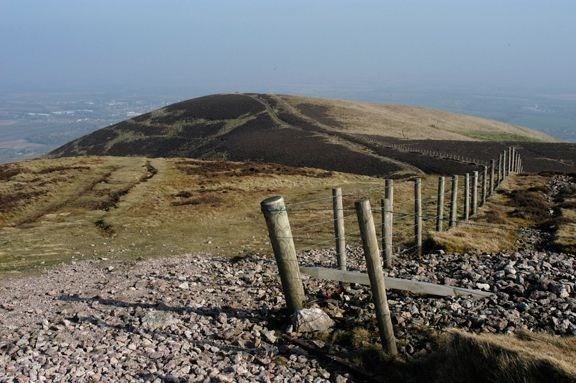Chapter Seven

Caerketton, Pentland Hills
A walk with Doctor Frost
Caerketton was the most prominent summit of the northern ridge of the Pentland Hills, with its black rock face above silvered scree slopes, towering above the T Wood. It was visible from virtually every corner of Edinburgh, a dark smudge in summer, snow-capped in winter and sharply outlined against the southern sky. To most inhabitants of Edinburgh, Caerketton was the Pentlands though few could claim to know its name. The sound of the word alone was magical. But what did it mean? James hadn’t a clue. He only knew it was Celtic and was very old. For James, Caerketton was his closest point of entry when the Pentlands became his personal playground. It had been Ian who’d originally introduced him to Caerketton and the Pentlands. As a teenager himself in the 1920s and 1930s, he’d been influenced by the spreading belief in British society that the public should be allowed more general access to the countryside. Like many other young folk forced to spend most of their time in the grim tenements and factories of industrial cities, the urge was strong to get out into clean air and areas of natural beauty. It had all come to a head in the mass trespass at Kinder Scout, Derbyshire, in 1932. The movement hadn’t been quite as strong in the country districts around Edinburgh. But Hillend and the Pentlands were only a tram ride away and access didn’t seem to be a problem. So, Ian and his pals would make the trip whenever they had time and the spare cash for the fare. That’s how he’d discovered Swanston golf course where he’d learned to play. Though no longer a club member after The War, when James was little he’d occasionally take his son all the way out to Swanston Village, nestled in the lee of the hills, walk him onto the course and reminisce about his younger days. These excursions had planted the seed.
When James was twelve, he’d bought a Bartholomew’s map of the Pentlands at Thin’s for 4s6d. The sky-blue linen cover had a line drawing of a shepherd with a flock of ewes. Then, poring over it night after night, he’d started to plan expeditions. At first, Ian and Janet were a bit leery of allowing him all the way out there on his own. But since he’d turned thirteen and had officially become a teenager, they’d gone along with it. He’d disappear for an entire day. Somehow, they trusted him to be sensible. Somehow, they assumed nothing would happen to him. He had no idea where their trust came from.
For the Pentlands, although only a stone’s throw from the city, presented a largely trackless wilderness of steep slopes, desolate moorland, deep reservoirs and muddy cleuchs, with the odd crag and rocky waterfall thrown in for good measure. There were no public telephones, no buses, no public roads and few dwellings, apart from scattered farm cottages; nor was there vehicle access, apart from a gated, dead-end private road from Flotterstone, built to service the reservoirs. In those days, the Pentlands were unknown, unexplored and undeveloped. Even at weekends they were almost entirely devoid of people, except for the odd farm labourer, Water Board worker, or, on the military training grounds at Castlelaw, soldiers. In this empty country it would be easy to disappear and never be found.
Unless you had a car, the only way to get to the edge of the Pentlands was by bus or tram, which could take up to an hour, depending on the time of day and the state of the traffic. Anyway, what sane person would take pleasure in slogging across miles of bleak hill and moorland, especially in the unpredictable east coast climate? Weren’t there far more important things to do in your spare time in the comfort of the City? Go to the pictures, drink in the pub, window shop in Princess Street, watch a Hearts or Hibs game, or, increasingly by the end of the fifties, sit glued to the television? Though James did occasionally come across other lunatics in the Pentlands, they were few and far between. He could easily walk an entire day with only ewes, rams, stirks, and curlews for company. As a result, a twisted ankle, a bad fall, and what had seemed like a carefree day out could easily have ended in disaster, or at the very least, inconvenience.
For his part, James, in his naïve way and barely into adolescence, had profound faith in himself. He’d borrowed books about hill climbing from Leith Public Library, had read them avidly and had taken their advice. He made sure he was prepared. He had good ex-army boots and rain gear. He took plenty to eat and drink and always had a backup of a couple of chocolate bars. He had a map, a compass and a wristwatch. If a winter walk was planned, he even packed a sleeping bag in the Bergen just in case, and wore his thick, waterproof parka. As soon as he’d seen it hanging on the rack in Millets with the fleece lining and hood with the fake fur border, he’d had to have it. It had cost a fortune, nearly £5, but he’d gladly raided his hoard of pocket money. He timed his walks, made sure that he didn’t overextend himself and that he was off the hill well before nightfall. Whether his preparations paid off, or whether he was just lucky, in all the years he traversed back and forth across the Pentlands, not once was he to suffer any mishap. The worst that ever happened was missing the green SMT bus home to the City and having to wait ages for another one.
Tom Richardson via Wikimedia